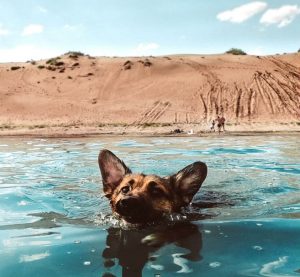Teaching Your Dog To Enjoy The Water
June 17, 2020

For some dogs, paradise is trip to the beach or a day spent splashing around in the backyard pool. But not all dogs love the water.
“Some dogs don’t even like to get their paws wet, let alone go in water,” says Russell Hartstein, certified dog trainer and CEO of Fun Paw Care in Los Angeles. “The bottom line is it always comes down to a dog’s preferences.”
You may never get your dog to love the water, but if you have a pool in your backyard or live near a body of water, it’s a good idea to try and teach your dog how to be comfortable in the water. You may even have to teach your dog how to swim because surprisingly, not all dogs instinctually know how to do the doggie paddle.
But if you can get your dog to swim, you should.
“Swimming has almost the exact same benefits for dog as it does for humans,” says Hartstein. It’s good cardiovascular exercise. It reduces stress. It burns off excess energy.
Swimming is joint-friendly. “It benefits arthritic dogs and helps with dogs who have issues with bones, joints and cartilage.”
It’s also beneficial for senior dogs because swimming is therapeutic. Water supports the dog’s body and makes moving easier. It can relieve pain by strengthening cartilage, joints, and muscles, and improving circulation.
If your dog is overweight, swimming is a perfect exercise. It is easy on their joints, burns calories, and improves the metabolism without the risk of injury.
To encourage your dog to enjoy the water, it’s important to create a positive associations with it. (Make sure you consult with a professional dog trainer or veterinarian before heading into the water.)
Introducing your dog to water should be a natural experience. When dogs see people in the water or kids who are playing in the pool, dogs often wants to be part of the fun, and that can positively influence a dog’s behavior, says Hartstein.
Put a life jacket on your dog before you work with him in a pool. Make sure it’s sized right for your dog. (For instance, if you have a bulldog, choose a jacket that is designed to keep the head above water.) Look for a life jacket with a float front and handle.
Don’t ever force your dog into the water. Never drag him in or throw him in. That method, called “flooding,” is not recommended, says Hartstein. “Unfortunately, I see dog parents along ocean and lake edges pulling their dog in the water, and clearly the dog is petrified,” he says. “That will backfire in a big way. There is a lot of emotional fallout. We have to respect the autonomy of the animal and just allow them to make their own decisions.”
If your dog is afraid of water, it’s best to start with a pool or a quiet lake or pond. Oceans and rivers with waves and currents are much more intimidating to a dog who’s fearful, and the intense stimulation of hot sand, noise and other people at a beach can be overwhelming.
Show your dog how to get into and out of your pool — but don’t expect him to use the ladder! If you don’t have a shallow side with a gentle slope or steps, invest in a pool ramp.
When your dog is in the water, hold him underneath his body, talk in a high pitch voice and show him that it’s okay, says Hartstein. “Use very high value food treats and reward your dog every time he comes closer to the water or dips a paw in.”
Try walking him in a shallow pool while you hold onto his belly, and then guide him to the steps or ramp to get out. Each time, give your dog a treat.
When the dog is more comfortable, try tossing a ball into the pool or a floatable dog toy. Or put it right at the water’s edge and then keep on progressively throwing it deeper and deeper.
If you have another dog who loves the water, or can invite over some water pups, they can often encourage your dog to relax and learn to love swimming.
Even if your dog loves the water and takes any opportunity to leap into the pool, that doesn’t automatically mean your dog is safe. In fact, there are breeds that are often physically unable to keep their head above water. Unfortunately, if an individual dog loves water, the fact that he will sink like a stone won’t deter him from leaping into the pool.
Some of these breeds include:
Bulldogs.Their large heads, limited range of motion, big heavy chests and breathing problems make bulldogs sink like a rock.
Basset Hounds. Short legs, dense bones and low heavy body shape causes them to sink to the bottom.
Pugs. They can sometimes swim, but their heavy, barrel-shaped body and short snouts make swimming difficult.
Dachshunds. This breed can also sometimes swim, but their long backs, short necks and short legs make swimming difficult.
Pekingese. The flat, brachycephalic facial structure and short legs make swimming risky.
Scottish Terrier. Short legs and a heavy body make this breed sink in water.
If you have any of these breeds, or any of the brachycephalic breeds in general, you must be extremely careful. When your dog is running around on your property, use a doggy life vest — or keep your dog on a leash, says Hartstein.
If you have a pool, the safest option is to install a fence around it, and keep it secured. Use a pool cover in the off season. There are also pool monitors that will alert you when you’re inside your home if your dog breaks the surface of the water.
Always supervise your dog around water, and be extra careful around natural bodies of water. Lakes, river and ponds can grow toxic blue-green algae growth, which is deadly for dogs. Stagnant water can be home to dangerous water parasites. Other dangers include water snakes, sharp objects like glass or metal, and heat stroke.
Stay safe and always consult with your veterinarian or trainer before you take your dog for a swim.


 When Luke Hengen’s diabetes worsened in his early twenties, it stripped him of the outdoor activities where the country kid felt at home. Countless wilderness adventures and years of hard-fought football games took a toll on his body, to the point where he could no longer sense when his blood sugar was too high or […]
When Luke Hengen’s diabetes worsened in his early twenties, it stripped him of the outdoor activities where the country kid felt at home. Countless wilderness adventures and years of hard-fought football games took a toll on his body, to the point where he could no longer sense when his blood sugar was too high or […] When middle school students return to class on Jan. 11, they’ll find a new face at the door: Daisy. Daisy is a therapy dog and the personal pet of Rob Kreger, principal of the Rock L. Butler Middle School. The five-year-old golden retriever is not a school pet or mascot, but rather a working dog […]
When middle school students return to class on Jan. 11, they’ll find a new face at the door: Daisy. Daisy is a therapy dog and the personal pet of Rob Kreger, principal of the Rock L. Butler Middle School. The five-year-old golden retriever is not a school pet or mascot, but rather a working dog […] Last March, Caroline Benzel, a third-year medical student, began to notice the stress and discomfort her nurse friends were feeling from the pressures of the ongoing Covid-19 pandemic. “[Personal protective equipment] can be really rough on the skin,” Benzel, 31, tells PEOPLE. Benzel and her 3-year-old Rottweiler, Loki (who’s also a therapy dog) hatched a […]
Last March, Caroline Benzel, a third-year medical student, began to notice the stress and discomfort her nurse friends were feeling from the pressures of the ongoing Covid-19 pandemic. “[Personal protective equipment] can be really rough on the skin,” Benzel, 31, tells PEOPLE. Benzel and her 3-year-old Rottweiler, Loki (who’s also a therapy dog) hatched a […] When Stanley the miniature fox terrier’s owner passed away, the little dog started a ‘paw-some’ new role – bringing puppy love to some of the Gold Coast’s oldest residents. After Carinity Cedarbrook Diversional Therapist Julianne Staff adopted Stanley, he began visiting the aged care community at Mudgeeraba as a therapy dog. Therapy dogs help to […]
When Stanley the miniature fox terrier’s owner passed away, the little dog started a ‘paw-some’ new role – bringing puppy love to some of the Gold Coast’s oldest residents. After Carinity Cedarbrook Diversional Therapist Julianne Staff adopted Stanley, he began visiting the aged care community at Mudgeeraba as a therapy dog. Therapy dogs help to […] A nonprofit is providing an unusual form of therapy for those on the front lines of the coronavirus pandemic – puppy cams! “You spend five minutes with a puppy and try not to smile,” said registered nurse Robin Lingg Lagrone. Lingg Lagrone says watching little furballs wag their tails and prance on their paws helps […]
A nonprofit is providing an unusual form of therapy for those on the front lines of the coronavirus pandemic – puppy cams! “You spend five minutes with a puppy and try not to smile,” said registered nurse Robin Lingg Lagrone. Lingg Lagrone says watching little furballs wag their tails and prance on their paws helps […] When Moore County’s school doors were abruptly closed earlier in 2020, two- and four-legged volunteers from the Moore County Citizens’ Pet Responsibility Committee (PRC) were in their 12th year of presenting a six-session Pet Responsibility Education Program for fourth-graders. The PRC quickly shifted gears and placed its program materials online as part of a home […]
When Moore County’s school doors were abruptly closed earlier in 2020, two- and four-legged volunteers from the Moore County Citizens’ Pet Responsibility Committee (PRC) were in their 12th year of presenting a six-session Pet Responsibility Education Program for fourth-graders. The PRC quickly shifted gears and placed its program materials online as part of a home […]